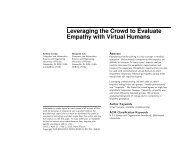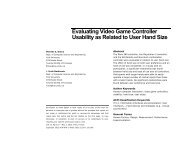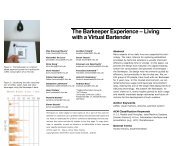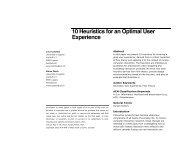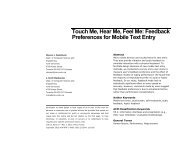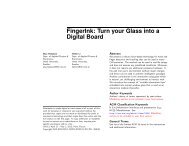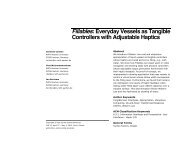Neurodiversity & HCI - alt.chi 2013
Neurodiversity & HCI - alt.chi 2013
Neurodiversity & HCI - alt.chi 2013
You also want an ePaper? Increase the reach of your titles
YUMPU automatically turns print PDFs into web optimized ePapers that Google loves.
Figure 1: A conceptual curve of ‘ability’ against ‘degree’ of<br />
condition.<br />
Users and spectrum<br />
From an <strong>HCI</strong> perspective, resear<strong>chi</strong>ng and responding<br />
to neurodiversity should be seen not as an extension of<br />
e-inclusion [1] and disability but more as a<br />
fundamental and subtle response to the wider diverse<br />
user community. If the neurodiverse are part of a<br />
spectrum, then being inclusive to other cognitive<br />
modes suggests wider benefits. For example, Alan Dix<br />
[14] observes that supporting assistive materials and<br />
technologies for neurodiverse students has an effect of<br />
making the material more accessible for the wider<br />
student population. It seems natural to suggest that it<br />
would be reasonable to expect that technologies that<br />
support assorted gifts from the neurodiverse<br />
community might have an audience much larger than<br />
the neurotypical. If we can support the gifted in the<br />
more specialist neurodiverse community, then it is<br />
natural that we might expect wider benefits.<br />
Giftedness<br />
Baum’s [7] work implies that we can consider the<br />
neurodiverse in relation to high functioning intellectual<br />
activity, and this is an area which has received little<br />
attention in the <strong>HCI</strong> literature. We need to see<br />
neurodiversity not only as approa<strong>chi</strong>ng issues of the<br />
negative sides of the conditions but as a new<br />
opportunity to study the positive gifted and talented<br />
aspects of conditions traditionally viewed as disabilities.<br />
There have been many calls to explore <strong>HCI</strong> 2.0 aspects<br />
such as creativity, sociability, joy, and user<br />
temperament[26]. What makes these aspects intriguing<br />
in terms of neurodiversity <strong>HCI</strong> [12] is that they are<br />
areas were the neurodiverse are typically very strong.<br />
As[2] suggests, it is in supporting the positive aspects<br />
of neurodiversity that members of the neurodiverse<br />
community can find value in themselves. One example<br />
of this is Aspiritech[23] which uses Asperger’s/autistic<br />
spectrum engineers to perform very high value testing<br />
of software. By doing so they are able to find more<br />
software defects than similar neurotypcially staffed<br />
companies. <strong>HCI</strong> is then challenged to facilitate new<br />
kinds of interfaces to support new kinds of value<br />
creation.<br />
<strong>Neurodiversity</strong> within computing and <strong>HCI</strong><br />
It is obvious but regrettable that <strong>HCI</strong> does not reflect<br />
the wider user community, in terms of gender, culture,<br />
ethnicity and other aspects. Yet for <strong>HCI</strong>, awareness of<br />
neurodiversity does highlight a number of aspects<br />
within our own community. This part of the paper will<br />
highlight this aspect as it may have an impact in terms<br />
of how the <strong>HCI</strong> community reflects upon itself and its<br />
evolution.<br />
In the book Microserfs author Douglas Coupland<br />
observes, "I think all tech people are slightly autistic.".



